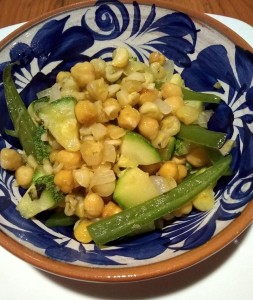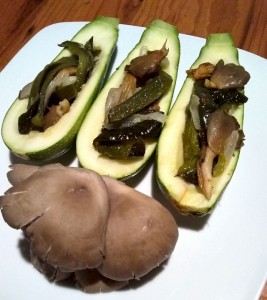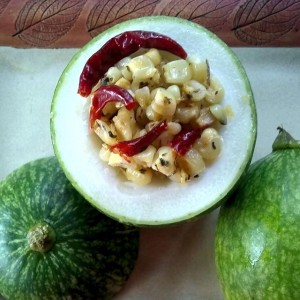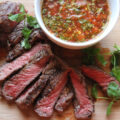Story by José C. Marmolejo
Modern agriculture has kept humanity fed against all catastrophic predictions of overpopulation, diseases and pests. Many scientific discoveries have kept us alive, fed and well; and research continues. There is, however, one scientific discovery that I consider amazing: the collaboration between legumes and other plant families. Legumes we know now, through an association with the right kind of bacteria, are able to fix nitrogen from the air into the soil for later absorption by other plants. Other species benefit from this phenomenon and corn is no exception.

Chickpeas and squash with serranos.

Squash stuffed with oyster mushrooms
Chiles, along with corn and beans, comprise the trilogy that became the foundations of traditional Mexican food. These three ingredients were to be present daily in all homes from pre-Columbian times to this day in a wide array of preparations and combinations. Thus the ancient agricultural production model of these staples, the Milpa, was here to stay. While the tortilla continues to be used as a dish when you add something on top—rolled or not—or an edible spoon when you cut it in half and using both hands to scoop your meal or a meal by itself when you just add salt and/or salsa, beans remain center stage waiting to be seasoned in multiple ways and be served on a dish or spread on a tortilla or tostada, and chiles reign as our “spice” of choice.

Chilacayote stuffed with corn
As you can see, the Mexican Milpa is very generous, nutritious, and best of all sustainable. Still found in Central and South Mexico, this method remains as a source of food, spice, and health to small peasants, an ecosystem for organic vegetables to grow, and a cultural treasure to Mexico… Perhaps we all should own a Milpa. If we have awakened some interest on how can you do a Milpa, follow us on to the second part of this post…
Recipes Milpa Mexicana Part 1
These vegetarian recipes call for cooked tender squash of a variety that suits your taste. They need to be baked, boiled or grilled whole to avoid loose their interior moisture and sweet flavor. Can be main or side to meat dishes.
Squash Stuffed with Oyster Mushrooms and Poblanos
A simple recipe that yields a complex flavor. If desired, you may devein the poblanos or enjoy the flavor plus pungency.
Ingredients
4 Squash cooked
4 Chiles poblanos roasted, sliced and seeded. Deveined optional
4 Oz. of oyster mushrooms sliced
1 Medium size onion chopped
2 Cloves garlic minced
Cooking oil or butter
Salt to taste
Instructions
Cut the squash lengthwise in half and remove the seeds. Reserve. Sautée between 3 and 5 minutes the poblanos, mushrooms, onions, garlic, squash seeds, and add the salt. Stuff the squash halves and enjoy!
Yield: 4 portions
Heat level: medium to hot
Chickpeas and Squash with Serranos
This dish can be eaten alone or used as a side to a meat dish or be the stuffing of quesadillas. Good at lunch or for a light dinner.
Ingredients
1 Lb. cooked chickpeas
4 Squash cooked cut in chunks
2 to 4 Chiles serranos sliced seeded. Deveined optional
1 Onion chopped
2 Cloves garlic minced
Cooking oil
Salt to taste
Instructions
Sautée between 3 and 5 minutes the chickpeas, squash, serranos, onions, garlic, and add the salt. It is ready to enjoy! Quick and easy!
Yield: 4 portions
Heat level: medium to hot
Chilacayotes stuffed with corn, epazote and chile de árbol
Chilacayotes are a spherical wild variety of squash. They are best harvested when their diameter is between 3 and 5 inches for our purpose.
Ingredients
4 Chilacayotes or any spherical tender squash cooked
1 Lb. sweet corn cooked
4 Chiles de Árbol stemmed
1 Onion chopped
The juice of two lemmons
A sprig of epazote. Substitute cilantro
Cooking oil
Salt to taste
Instructions
Cut about an inch in the top of the chilacayote on the side of the stem and remove the seeds. Reserve. Sautée the corn, chiles and onions for about five minutes. Add the lemon juice, epazote and salt, and sautée for another three minutes. Stuff the squash with the sauteed mix and serve! Buen provecho!
Yield: 4 portions
Heat level: hot
Latest posts by José C. Marmolejo (see all)
- Unconventional Seafood Salsas - 04/25/2022
- Cocineras Tradicionales: The Traditional Cooks of Mexico - 04/01/2022
- Carnitas Calientes - 03/11/2022










